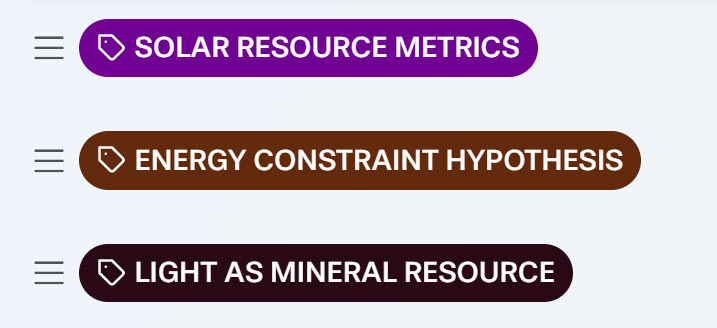Lesson 5 Discussion in Yellowdig!
In this lesson we have been discussing the value of goods in an economic sense. The tendency in the public is to judge the value of a solar technology in a given locale based on metrics (perceived or measured) of the quantity of light (MWh). But I would like you to consider an alternate valuation system related to the value of a mineral resource.
So, this week discuss the following questions in Yellowdig:
Note: Here the subscript "p" stands for "peak", meaning that system performance is measured at AM1.5 lab conditions of 1000 W/m2 solar shortwave spectrum irradiance and cell temperature of 25°C. It is a way to normalize performance when comparing modules/systems. The peak watt is also used to describe the "installed capacity" of solar farms or rooftops.
2. Which metrics - irradiation (MWh) or dollars per peak watt ($/Wp) do you think will be more important to communicate to a client and stakeholders for solar energy project design?
Another topic in this lesson that deserves some discussion is the hypothesis of energy constraint response. You already had a chance to review your locale sunlight resource and perception earlier in this class, so do you see any evidence of this hypothesis being true for the area you live in?
You can review the following information to develop your conclusion on this topic:
- Does your family or do your friends in the area feel that you have "enough" sunlight?
- What is the cost of electricity in your area (0.06/kWh is low, and 0.12/kWh is considered high)?
- Are there any incentives in your area for solar energy?
- How active is the solar market in your area?
Do you think that the above observations support or disprove the hypothesis of the energy constraint response? I would be curious to hear your opinion.
When thinking about the solar resource in an economic framework, try to be objective and describe the conditions that you observe around you, rather than what you think "ought" to be happening. Most of us have not really framed the solar conditions in rational terms. If you have conflicting ideas about light and irradiance from your own background, feel free to discuss those and see what others think.
Tagging
When you create a post in the Yellowdig discussion space, you are required to choose a topic tag. For Lesson 5 discussions, please use these tags:

You can tag your post with one or several topics at the same time (just be sure to address all those in your post). All posts and contributions you create are added up to one score at the end of the week.
Importance of interaction
Yellowdig tip: Post early in the study week - that way you have higher chance of generating interest and traffic on your post, which gets you points!
Grading
Yellowdig points you earn over the weekly point earning period (from Saturday to next Friday) will count towards 1000 pts. weekly target. But you can go above it (to 1350 pts. max). Yellowdig discussions will account for 15% of the total grade in the course. Check back the Orientation Yellowdig page in Canvas for more details on the points earning rules.
Deadline
There is no hard deadline for participating in these discussions, but I encourage you to create your posts early in the study week to allow others to engage and respond while we are learning specific topics in the lesson. Also, remember that each weekly point earning cycle ends Friday night, and a new period starts on Saturday.
